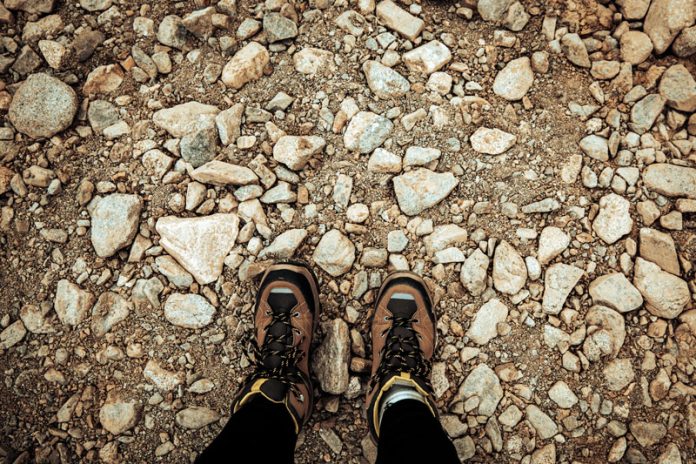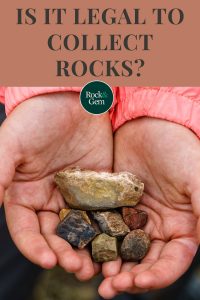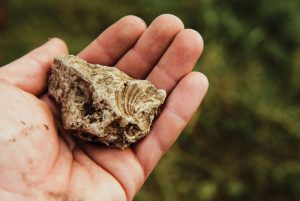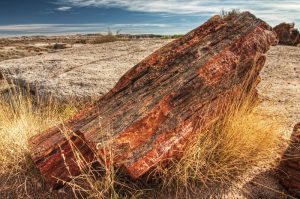
Rock collecting isn’t just for hardcore rockhounds. All types of people, young and old, who find a pretty rock on a hiking trail or side of the road may put it in their pocket and take it home.
But is this breaking the law? Simply put, maybe. It depends on where the rock was found. Private land is relatively straightforward, but on public land, it’s not as clear-cut.
Can You Collect Rocks on Roadsides?

Finding a rock on the side of the road and keeping it probably wouldn’t give most people pause, but sometimes it’s illegal. Each state and local government has unique rules regarding roadside rock collection, so what might be completely legal in one area may not be in another. Generally speaking, collecting small quantities of small rocks from roadsides and ditches on public property isn’t a problem. Collectors should still ask first, but it’s likely okay. If the roadway or ditch is on private property, get the owner’s verbal, preferably written, permission first to avoid potential problems.
Can You Collect Rocks on Government Land?
Collecting small, loose rocks easily found on the surface may not seem like a big deal. However, based on where those rocks are located, it could cause the collector some major grief. For the most part, the Bureau of Land Management (BLM) and the U.S. Forest Service (USFS) won’t mind, but the National Park Service (NPS) will.
According to a BLM spokesperson, “the collection of mineral specimens is allowed on public lands in most cases. Collection of rocks and gems is limited to a reasonable amount … The limits for petrified wood are 25 pounds plus one piece per day and no more than 250 pounds in a calendar year for non-commercial use.”
Collecting isn’t allowed in some BLM areas, so contact the local field office to determine whether an area has any special designation that precludes collecting.
Kevin Johnson, Geologist with the USFS, Minerals and Geology Management, said individuals can usually collect rocks on USFS land, but it depends on what is being collected and on the status of the land.
Check Ahead of Time
“In some areas, such as Wilderness, National Monuments, etc., rockhounding may be restricted,” explained Johnson. “Check with the local Ranger District for information. Depending on the type of material to be removed, it may be subject to specific laws, such as the General Mining Act of 1872 as amended, mineral withdrawals, or the lands may be split estate where the United States owns the land but not the minerals.”

Alternately, Cynthia Hernandez, NPS spokesperson, said “collecting, rockhounding and gold panning of rocks, minerals and paleontological specimens, for either recreational or educational purposes is generally prohibited in all places in the National Park System. Violators of this prohibition are subject to criminal penalties.”
Hernandez said there are two exceptions. Limited recreational gold panning is allowed in the Whiskeytown Unit of the Whiskeytown-Shasta-Trinity National Recreation Area in California. Some Alaska parks allow the surface collection of rocks and minerals by hand for personal use only, excluding the collection of gemstones, silver, platinum or fossils.
Do You Need a Permit to Collect Rocks?

Getty Images
Most casual rock collectors won’t need a permit to collect rocks on BLM or USFS land. However, individuals using certain implements or collecting larger amounts of rocks or minerals may need one.
Collectors on BLM land who remain on-site for less than 14 days and only use casual collection methods usually won’t need a permit. Casual collection involves an insignificant amount of disturbance to the land using hand tools only. If using mechanized equipment, a permit will likely be required. Contact the local field office to learn whether a permit is necessary.
USFS Permits
The USFS doesn’t usually require permits if the lands are open to collecting, aren’t claimed by someone else and there won’t be any significant disturbances to the surface. A permit may be required when rockhounding for minerals that aren’t considered valuable; especially if one intends to remove large amounts that could create surface disturbances, or for commercial use. Check with the local Ranger District, especially in areas where heritage or archaeological sites or threatened or endangered plant or animal species exist.
Hernandez said there’s a permit process for recreational gold panning in the Whiskeytown Unit of the Whiskeytown-Shasta-Trinity National Recreation Area in California, but no other types of rocks, minerals or gems may be collected with or without a permit.
What About Fossils or Petrified Wood?
The BLM is open to the non-commercial collection of petrified wood in most areas and non-vertebrate fossils of reasonable amounts. However, the collection of vertebrate fossils isn’t allowed without a permit, which is only issued to scientific entities, such as museums or universities.
“If a vertebrate fossil is found on BLM lands by members of the public, the fossil shouldn’t be disturbed,” said the BLM. “Leaving fossils undisturbed helps maintain scientific information that helps advance our overall understanding of the fossil record.”
Bruce Schumacher, Paleontology Program Lead with the USFS, WO Minerals and Geology Management, said, “A person may collect fossils from most National Forest System lands without a permit if the fossils are common invertebrate or plant fossils, collected for personal use and not for resale, and gathered by hand or with small nonpowered hand tools resulting in negligible disturbance.”
Collecting vertebrate fossils, or collecting any type of fossil, for research purposes on USFS lands requires a permit. Schumacher said if a person isn’t sure whether a fossil is common, they should report the find to the local Forest Service office before disturbing it. Individuals also can collect limited quantities of petrified wood under a free use permit for personal use but bartering/selling the wood is prohibited. Local Forest Service units have designated collection areas and varying limits on how much petrified wood can be collected.
Illegal Rock Collecting
Collecting rocks where it’s illegal to do so could lead to legal consequences. Penalties vary by jurisdiction and may be severe.
“Violators may be subject to criminal penalties, including fines and imprisonment not to exceed six months,” said Hernandez of the NPS.
Johnson said, “Depending on the locality, land status, amount of disturbance and volume of material taken, a person could be cited or charged for damage to a natural feature or removal of other property of the United States … other criminal charges could include fines, imprisonment or restitution for repairs.”
Consequences of Illegal Collecting
Citations or other legal consequences are likely from the USFS for damaging or removing any heritage or archaeological resources. Also, removing valuable minerals from a mining claim could result in legal action for mineral trespass in the state court system.
The BLM said, “Causing resource damage or unnecessary and undue degradation on public lands can be punished with up to a $100,000 fine and/or 12 months in prison.”
To ensure compliance with all rules and regulations, always seek permission to collect rock in an area of interest if it’s not explicitly noted that it’s okay. Even with permission, whether implied or through verbal or written consent, rock collectors should also be familiar with any conditions or limitations tied to a site, specimen or planned activity that could turn legal rock hunting into illegal activity.
Is It Illegal to Collect Rocks From State Parks?
Like national parks, most state parks don’t allow visitors to remove rocks even for personal use. States prohibit rockhounding to protect their parks from potential damage. In states where rock collecting is legal, a permit may be required and may only be available for certain groups. A few states have parks especially dedicated to collecting rocks. Laws/ rules can change over time, so always check with park officials before taking anything to avoid legal issues.
Rock Collecting in State Parks by State ListAlaska -Prohibited from taking Arizona -Prohibited to remove from any park facility Colorado -Prohibited on parks and outdoor recreation lands Delaware -Not explicitly implied, assume it’s prohibited Florida -Prohibited with permits granted for scientific research Georgia -Prohibited from being disturbed or removed Hawaii -Prohibited to disturb Illinois -Illegal to remove Indiana -Illegal to collect rocks or fossils Iowa -Illegal to remove Kansas -Prohibited to remove Kentucky -Prohibits collecting for any purpose Louisiana -Prohibited to intentionally remove or disturb Maine -Prohibited to remove Maryland -Prohibited to remove or disturb Massachusetts -Prohibited to remove or disturb Minnesota -Prohibited in state parks and state scientific and natural area Mississippi -Prohibited to remove or gather in any manner Missouri -Prohibited to remove Montana -Prohibited to remove Nebraska -Prohibited to remove or disturb Nevada -Prohibited to remove New Hampshire -Prohibited to remove or disturb New Jersey -Prohibited to dig up or remove New York -Prohibited North Dakota -Ilegal to remove or disturb with violation a non-criminal offense Oklahoma -Prohibits rock collecting but can collect crystals at the Great Salt Plains State Park Oregon -Prohibited to pick or remove Pennsylvania -Prohibited to remove Rhode Island -Prohibited to remove South Carolina -Illegal to remove, take or gather South Dakota -Illegal to remove Texas -Prohibits collecting Utah -Prohibited and can be charged with a Class B misdemeanor for removing or possessing any natural resource Washington -Prohibited |
This story about is it legal to collect rocks previously appeared in Rock & Gem magazine. Click here to subscribe! Story by Moira K. McGhee.













